Lou Leto August 16, 2022 All Feature Vehicles
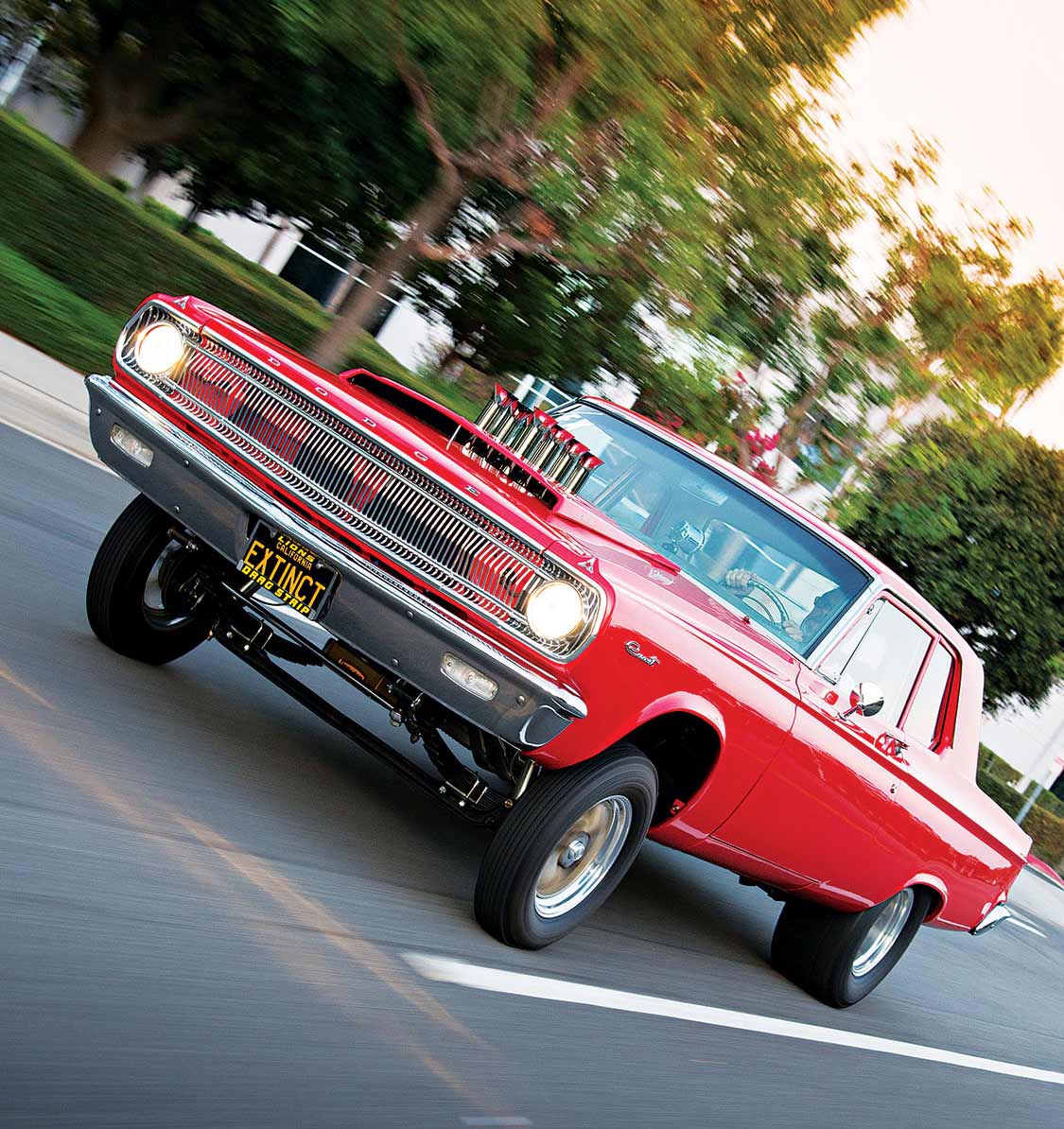
Many of today’s drag racing fans may not know that the ’60s was an era where advancements in speed and equipment moved quickly in an extremely short period of time, often with dramatic and unpredictable results. There was a major shift from “once was” to “what soon would be.” Beginning in the late-’50s, the Gasser wars were a significant part of the show. Fat-fendered Fords, Chevys and Willys did battle with Anglia and Thames creations. They were called Gassers and came in every trial-and-error configuration that could be dreamed up. Powered by supercharged or injected big-inch Oldsmobile, Caddy, Chevy and early Chrysler Hemi engines, these were the dominant crowd pleasers.
Loyal fan bases were formed following the antics and victories of Stone Woods & Cook, “Big” John Mazmanian, the Kohler Bros., Ohio George Montgomery, K.S. Pitman, Junior Thompson and many more. So popular and notable were these teams that they often secured equal sponsorships and billing as the Top Fuel drivers of the day. These wild machines drew crowds, and track promoters from around the country seized the moment and booked pairs of Gassers for organized match race appearances.

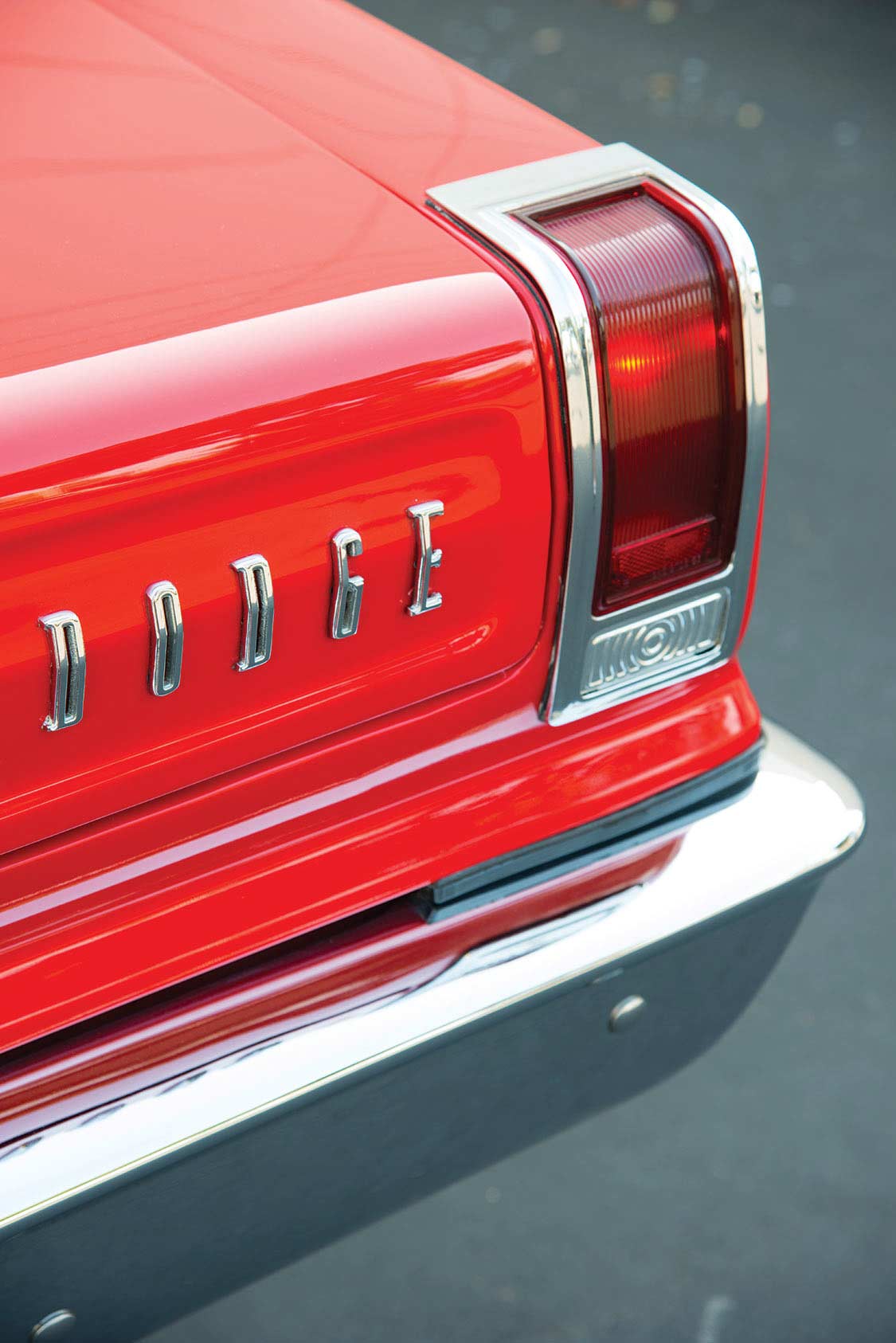
Another class that had a strong following was Fuel Altered. These cars were popular due to their over-powered, short wheelbase, big cubic inch combinations with exposed drivers making eye-watering, ear-shattering, ill-handling and sometimes ill-fated runs.
However, during the ’60s, change was in the wind and a dramatic, significant advancement would soon all but push the Gassers and Altereds into the deep shadows.
Major automobile manufacturers studied potential buyer demographics and noticed the rapidly growing attendance at stock car and drag racing events. The manufacturers’ racing band that had existed since the late-’50s (but none truly kept to) was broken. By 1963, the Big 3 were heavily involved in the development of competitive vehicles for the strip. The marketing folks adopted the philosophy of “what wins on Sunday sells on Monday” and eagerly touted the victories of race teams with back door, factory-sponsored relationships. They encouraged the production and support of higher horsepower engines, stuffing them into lightweight street models, similar to those offered for sale through Main Street dealers.
Vehicles that looked like those on the track were selling like hotcakes off showroom floors. Ford 390s became 406s that grew to 427s. Chevrolet, already with a legendary 409 (an expanded 348), developed a mystery 427. Pontiac had versions of a 421 all the way up to a full-race Super Duty. Dodge and Plymouth engines, some already with unique Ram-tuned manifolds, quickly enlarged from 361 to 413 to 426 cubic inches. Then hemispherical cylinder heads were updated from their effective ’50s design and were bolted on the 426 block. The amount of offerings from all of the OEMs as well as the aftermarket quickly grew, and rapid parts development created valve train and multi-carburetion combinations that could be bought over the counter in the dealer parts department and speed shops even before the next vehicle models came out.
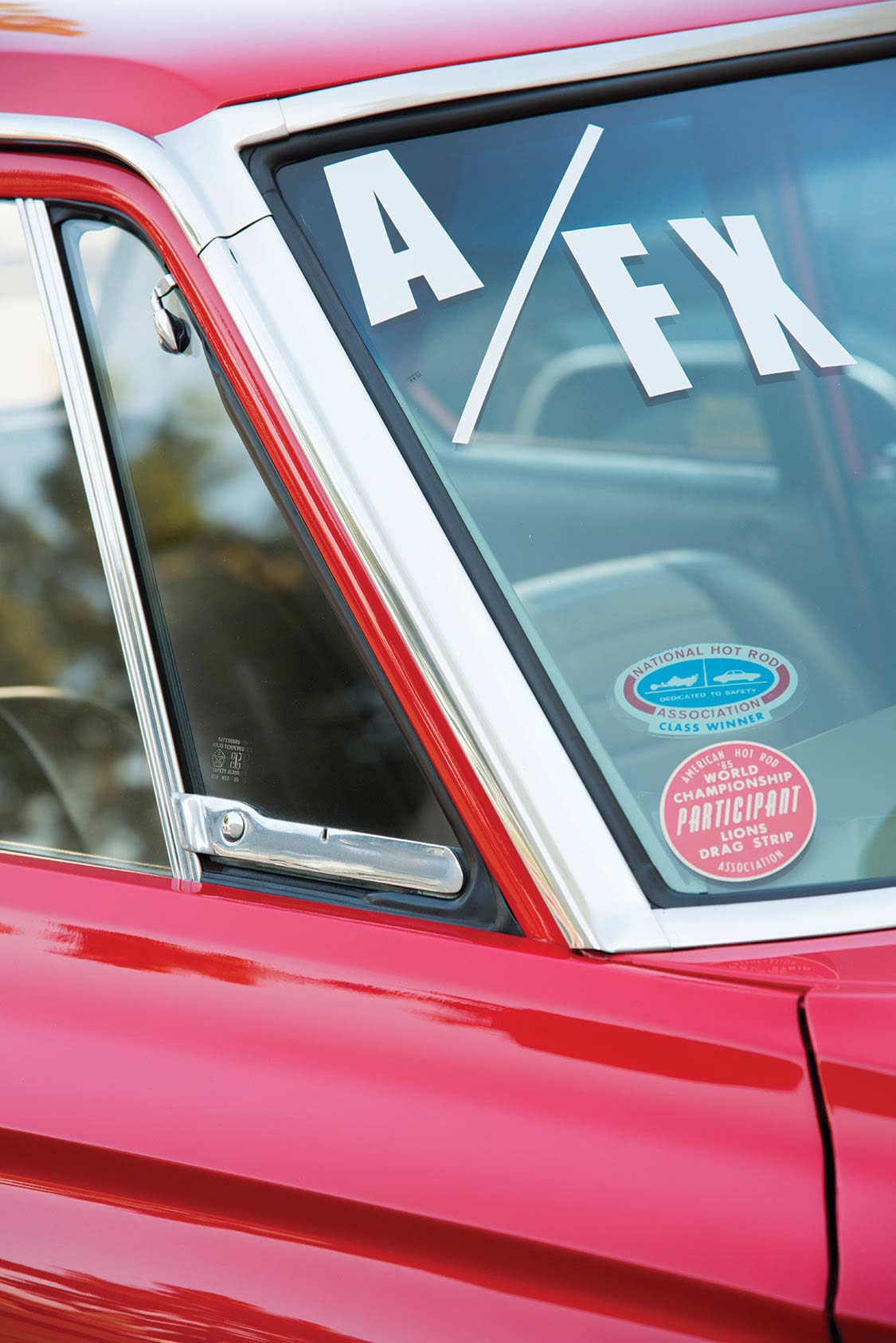
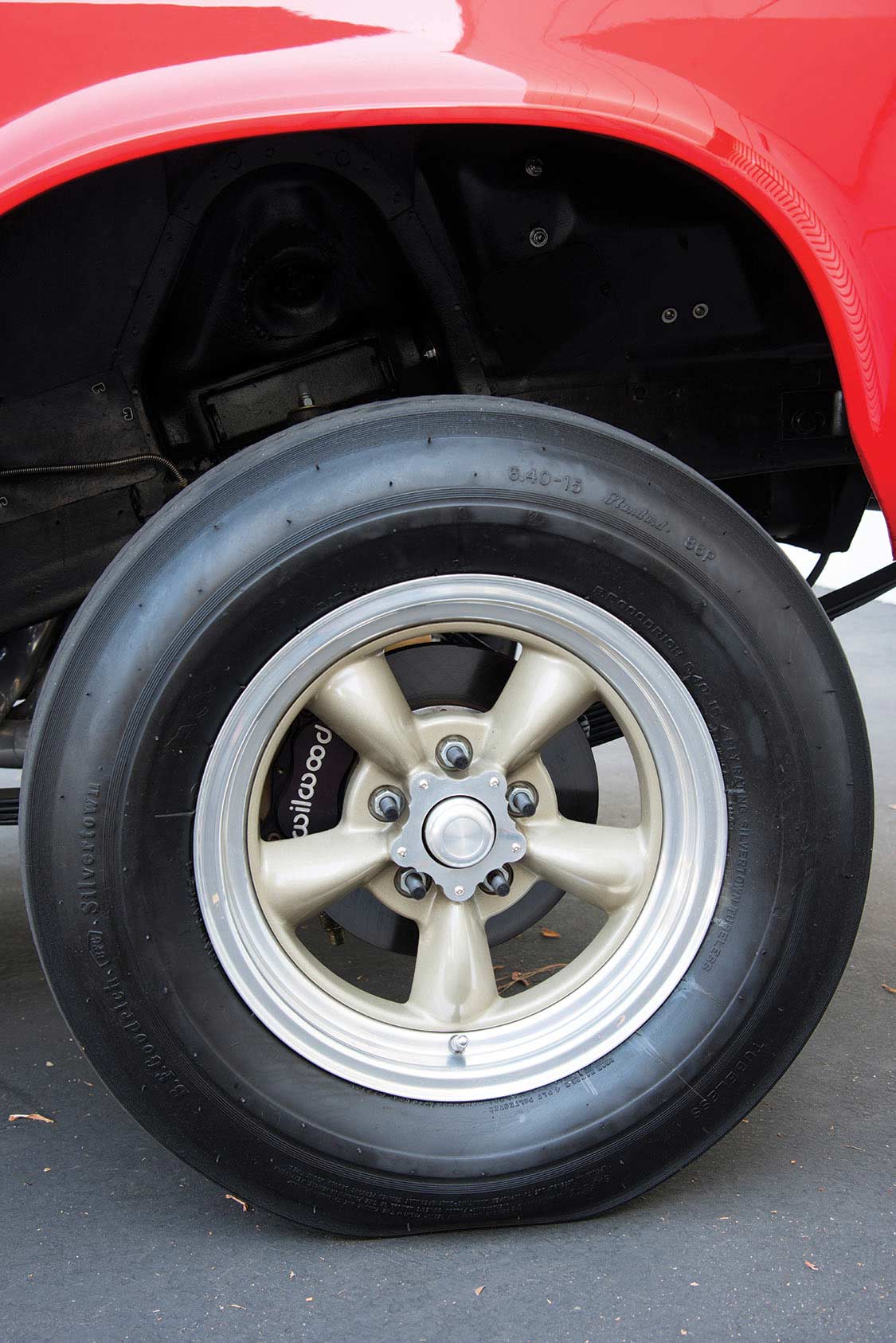
Meanwhile, back at the drag strips, brand-new vehicles were filling the fields, some appearing with sponsorship from local car dealers. Brand loyalty was being built, with legions of fans coming out to cheer for the make of their choice, be it Ford, Mercury, Chevy, Pontiac or the mighty Mopars from Dodge or Plymouth. Tech articles and new vehicle tests by the enthusiast magazines were spreading the gospel to their readerships, many that were now armed with this information and going to their dealers to special-order vehicles or buy updated parts.
In 1965, the management at the various automobile factories was in a virtual no-holds barred frenzy that included encouraging and funding engineering and experimentation with large budgets all targeted to beat their competitors at the track and in the dealer showrooms across America. An assortment of stock classes was where all of the emphasis lay, since the race cars looked like the makes and models the general population could buy. The dealers got involved to compete in some of the lower classes of A through H stock, depending on the weight and horsepower combinations, to dominate brand victories. Super Stock (S/S) was the most popular class in drag racing and became the major battlefield for the big-inch engine offerings. Though the cars were the stars, the drivers, many now with factory funding assistance, became known names with significant fan followings. Some had been recruited away from earlier allegiances, examples include: “Dyno” Don Nicholson, who moved from Chevy to Mercury; Butch Leal, who bolted from a Ford Thunderbolt to Plymouth; Sox and Martin, who moved from Mercury to Plymouth, and Dick Landy, seen earlier piloting a Plymouth, stayed in a Mopar, but ultimately went to a dandy Dodge.
In 1965, Super Stock drag race vehicles quickly evolved, so quickly that ’65 is still recognized as having the most significant changes in a one-year period. Manufacturers were rapidly creating new iterations within that model year and continually lobbying the largest sanctioning drag racing organizations for concessions. While the National Hot Rod Association (NHRA) was the largest group, there were other sanctioning bodies with their own member tracks. Factories were developing unique and more powerful limited edition parts and versions of their vehicles that they wanted to be approved. The pressures on the competing sanctioning organizations were great; if they did not approve, then the manufacturers simply encouraged their factory-sponsored teams to avoid the sanctioned tracks that did not approve and race at other venues.
in 1965, the management at various auto factories was in a no-holds barred frenzy that included encouraging and funding engineering and experimentation.
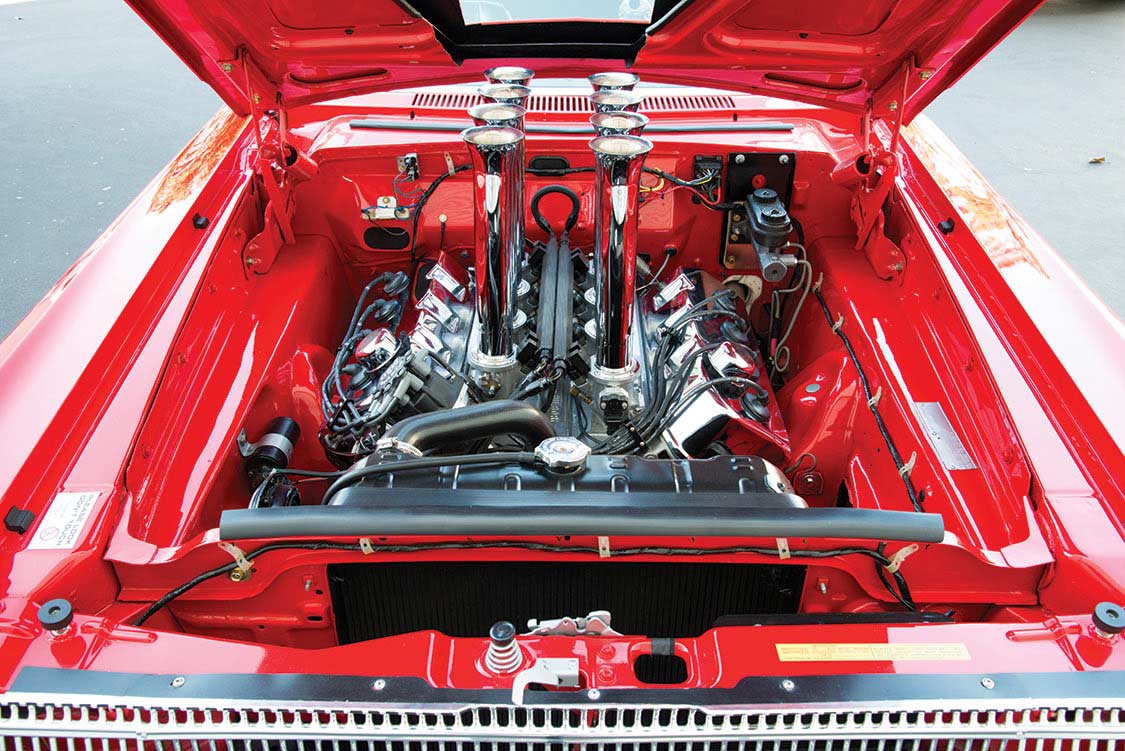

The first development phase of special cars in 1965 included acid-dipped bodies, equipped with smaller, lighter bucket seats that replaced front bench seats; special fiberglass or aluminum front fenders, hoods and bumpers were developed, along with thinner side glass, all to save weight. Vehicles equipped with these items were still stock in appearance to fans and still were using carburetor-equipped engines.
The next phase of Dodge and Plymouth development were the “2% cars.” There were a handful of factory vehicles that had front axles moved 2% off the wheelbase forward, a bit over 2 inches. Some used dropped axles originally located under the little Dodge A100 vans. The changes to the 2% cars were approved by NHRA, along with 10-inch-wide rear drag slicks, was all about trying to obtain an effective weight transfer, to shift more weight emphasis during the launch to the rear wheels for added traction advantage. While barely perceptible to the fans, these vehicles were relegated to a new classification known as Factory Experimental, or FX. The vehicles with the largest engines became A/FX, with smaller engines in B/FX. The fuel delivery quickly was converted from carburetors to a Hilborn fuel-injection system equipped with tall stacks sticking out of the hood.
A bit later in the same 1965 season, Dodge/ Plymouth factories developed 12 special vehicles with severely altered wheelbases, the rear wheels moved up 15 inches, and the front wheels moved forward 10 inches. They were an immediate hit with ticket-buying fans. These morphed, wild-looking cars also toured the country in crowd-pleasing match racing events. Independent racers started radically modifying their privately owned vehicles, some directly copying the look of the factory altered wheelbase (AWB) vehicles; others were just crude interpretations that looked odd. Probably more than one track announcer described these as “funny-looking” cars. From these humble beginnings, this trend of radically changed stock vehicles paved the way towards continued extensive modification and development that became what is now commonly referred to as Funny Cars.
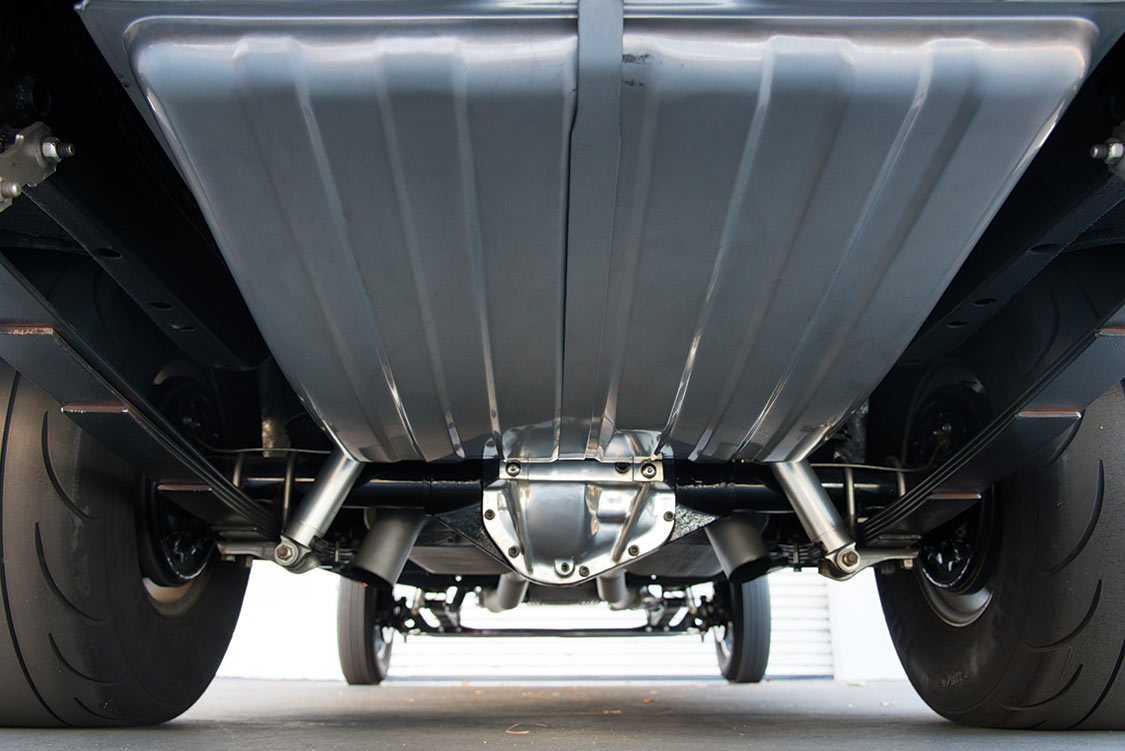
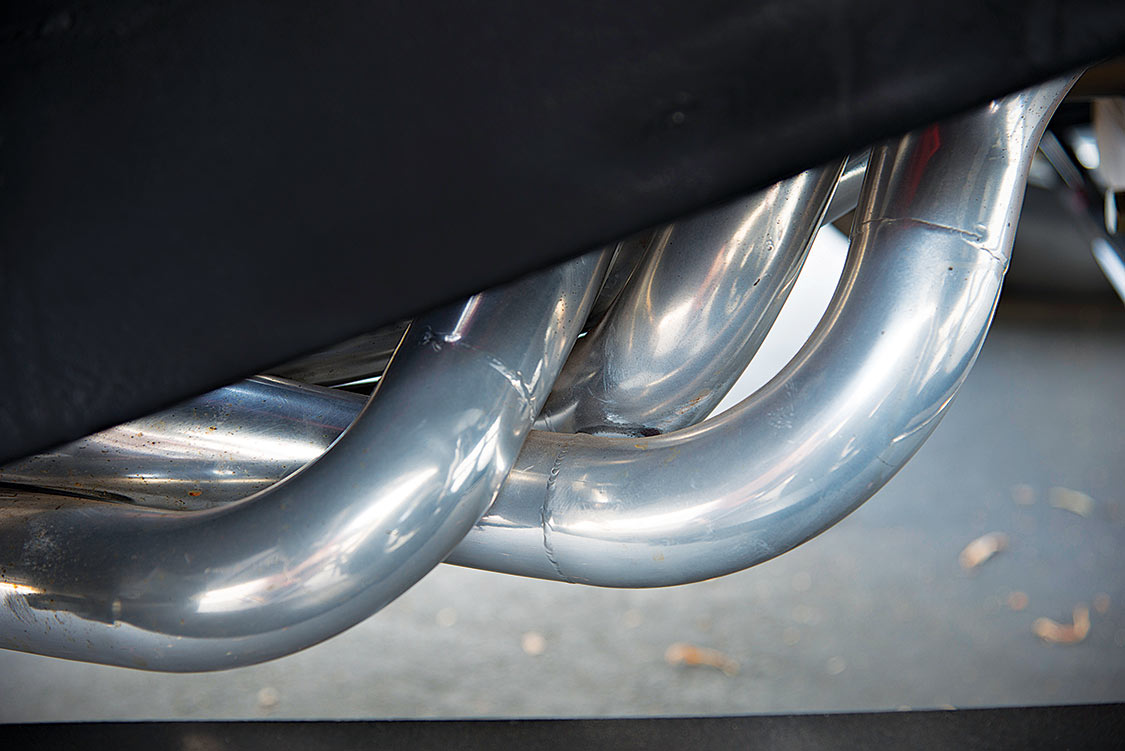
Jim Hetrick was a die-hard drag racing fan, attending many of the events back in the day. Hearing him describe the evolution of Super Stock into FX cars, with their accompanying match-race madness, is a distinct learning experience since he’s more passionate talking about Mopar-powered vehicles than any other topic. Rather than hemoglobin running through his veins, he must have “Hemi-globin.” He describes seeing Dick Landy’s Dodge, with the tall Hilborn stacks poking through the hood, and admits it made a lasting impression.
Fast forward to modern times. While Jim has stayed brand loyal, with an original Hemi Road Runner and a Hemi Dart, he missed owning the one that made the most significant impression. On the search for a proper car, he found an A990 tribute. “Only 101 Dodge A990’s race-Hemi-powered, lightweight, purpose-built drag race cars were built by the factory in 1965. As Jim related, “All were post cars [two-door sedans] that had Champagne interiors. The Dodge A990 tribute that I found five years ago was fairly correct, powered by a near stock-looking but larger 528-cubic inch Hemi crate motor, with 10:1 compression, TTI headers and a big cam. It sounded strong! The personal touches by the owner included a red interior, the wrong cross-ram intake manifold, a floor-mounted shifter in place of the automatic, and the wrong steering column. I had been searching for a car for six months. This one was a good starting point, but I wanted to make mine period-correct accurate.”
Surrounding himself with like-minded, talented, Mopar-fanatic friends, he enlisted the services of Brian Dickey of Dickey’s Hot Rod Shop in San Clemente, California to seek out and install a Gary Ball interior in the proper Champagne hue. “Brian also pulled the dash out, painted it Champagne, and installed the correct steering column equipped with a column shifter,” Jim told us.
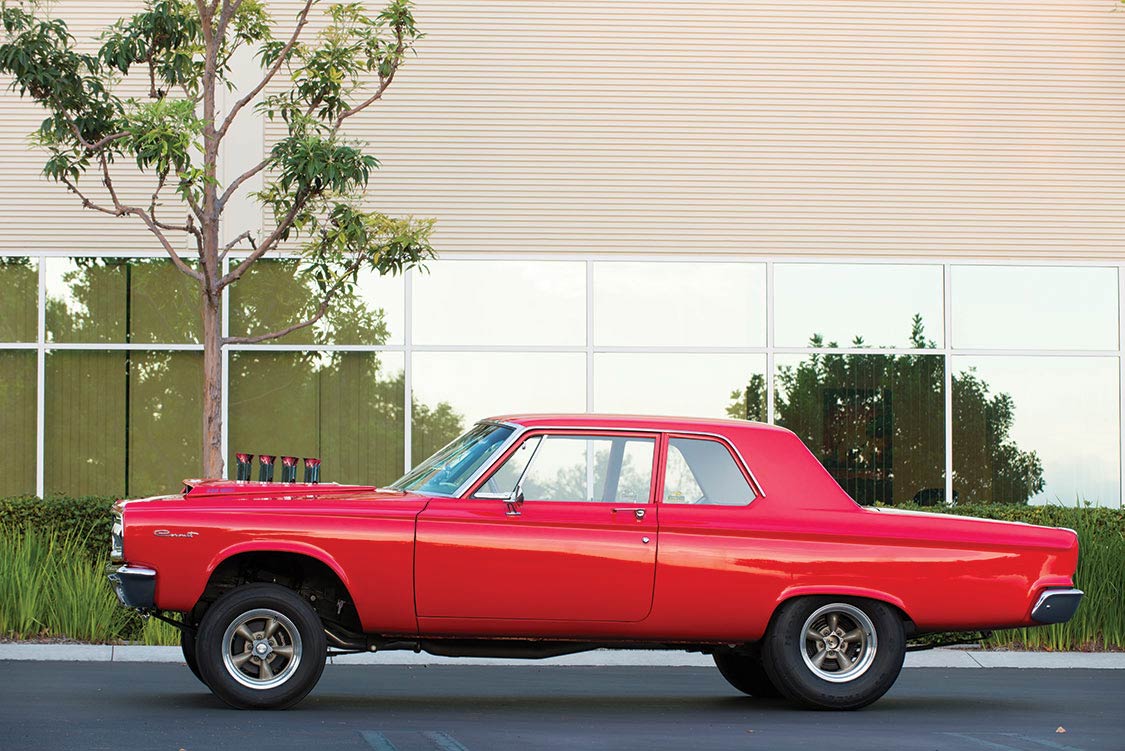
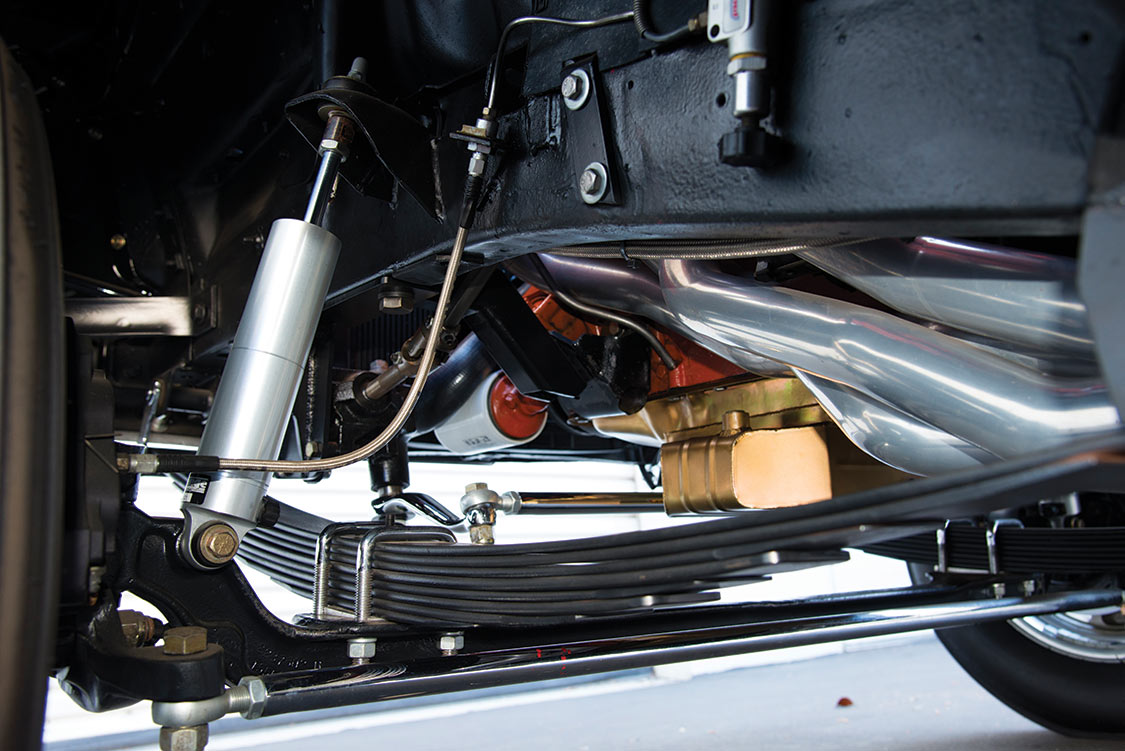
Within two months after purchase, Jim put the Hemi on a carb-free diet and installed a Hilborn fuel-injection system. “It’s an EFI system suitable for street use,” he says. “I wanted the 13-inch-tall stacks sticking out above the hood scoop that had been cut away, just like in ’65. The stacks were custom-built from aluminum tube stock supplied by Hilborn. I even made certain that it has the proper black stripes near the top. Those stripes back then were actually electrical tape, the look is also period-correct. As the factory teams were experimenting with tunable stacks of various lengths, they discovered that the longer/taller tubes offered more torque. The bells at the top of the stacks were affixed with the black tape.”
The most dramatic change was to the front suspension. All of the stock components were removed and replaced with a dropped front axle from a Dodge A100 van, just as had been done in 1965. Jim credits Dale Snokes and his shop, The Metal Shed of Pomona, California, for the correct conversion. The rear was mini-tubbed. “Dale took one week,” Jim told us. The rest of the suspension, engineered for street use, is equipped with QA1 shocks with factory-style Super Stock leaf springs at the rear, along with a pinion snubber on the 3.54 with Sure Grip-equipped Dana 60 rear axle.
The Torch Red (a modern Corvette color) Dodge rolls on American Racing wheels: 10 inches wide on the rear, strapped with M/T Drag radials sized 315x50x15. Fronts are 4.5-inch widths, with era-correct BF Goodrich Silvertown tires in the proper 6.40×15 configuration.
It brings back memories of a brief moment in drag racing at the influential beginning stages of what has become the popular, long running NHRA Funny Car class.
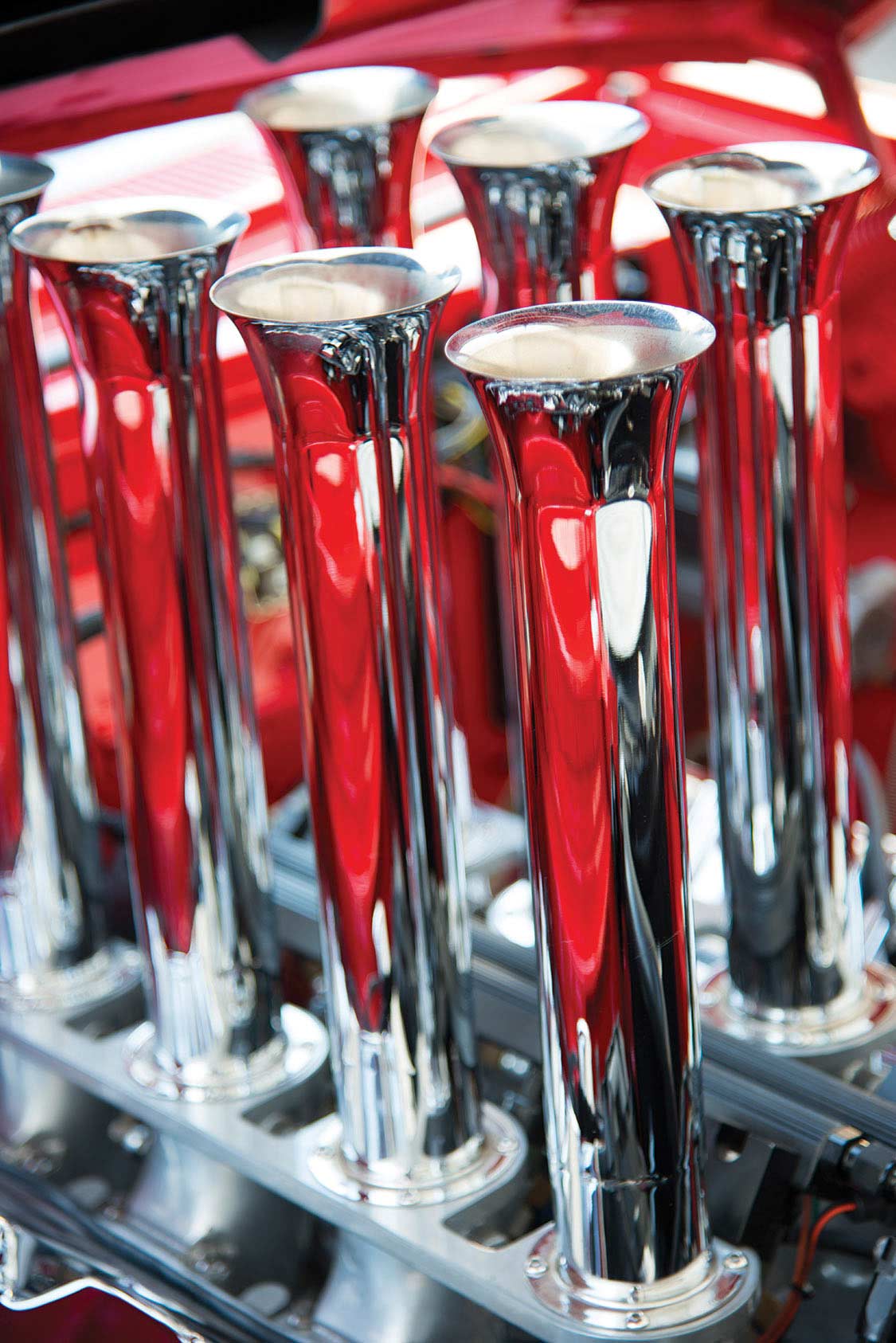
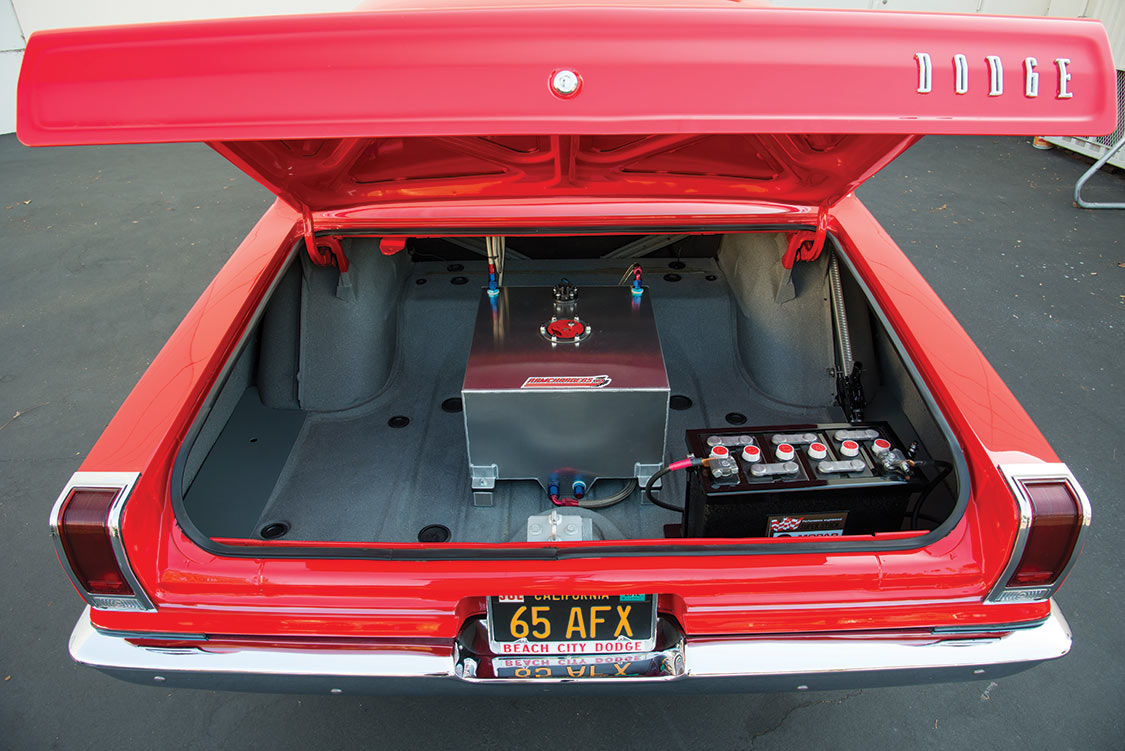
Jim has driven his Dodge often. “With a FAST self-tuning box installed last October, it’s now a much better-driving car. It’s been to many car shows and gatherings, winning awards at the John Force monthly show, the Cruise for a Cure and the Labor Day Show at Orange County Fairgrounds. It was featured in the Hot Rod Junction during an NHRA race in Pomona. While at the Triple A Show, Funny Car legend Tom “the Mongoose” McEwen came by and signed the car,” Jim proudly states. “The car is best appreciated by folks today that know the significance this type of car contributed during that era.”
It’s hard to believe that 50 years have passed since this experimental version from Dodge was an FX that was a popular track teaser and crowd pleaser. It brings back memories of a brief moment in drag racing that was at the influential beginning stages of what has become the popular, long running NHRA Funny Car class. If he could, the late Dodge legend Dick Landy would probably still admit: It’s a dandy.